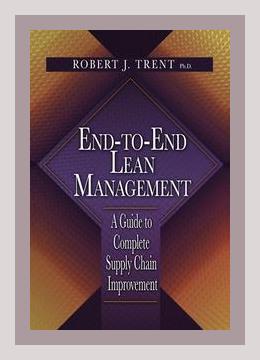Operations and Supply Chain ManagementLogistics
Introduction
“End-to-End Lean Management” by Robert Trent delves into the principles and practices of implementing lean strategies across the entire supply chain. Published in 2008, the book provides an in-depth guide to achieving complete supply chain improvement through lean management techniques. It covers a wide range of concepts from understanding lean fundamentals to practical applications in real-world scenarios. Below is a structured summary that includes the major points of the book along with specific actions for implementation.
1. Understanding Lean Principles
Major Point: The Origins and Evolution of Lean
– Example: Robert Trent begins by detailing the origins of lean management, particularly its roots in the Toyota Production System (TPS).
– Action: Study the history and principles of TPS to comprehend the foundational elements of lean management.
Major Point: Key Lean Concepts
– Example: The book discusses core lean principles such as continuous improvement (Kaizen), value stream mapping, and waste elimination (Muda).
– Action: Create a glossary of lean terms and concepts for reference and deepen understanding through workshops or training sessions.
2. Identifying and Eliminating Waste
Major Point: Seven Types of Waste
– Example: Trent identifies the seven crucial types of waste: overproduction, waiting, transportation, extra processing, inventory, motion, and defects.
– Action: Conduct regular waste audits in the supply chain to identify and categorize waste types, using a checklist based on the seven categories.
Major Point: Value Stream Mapping
– Example: Value stream mapping is highlighted as a pivotal tool to visualize and optimize processes.
– Action: Organize a team to perform value stream mapping sessions targeting different segments of the supply chain, identifying areas for improvement.
3. Lean in Supplier Relationships
Major Point: Building Lean Supplier Networks
– Example: The book emphasizes creating strong, collaborative relationships with suppliers to extend lean principles beyond organizational boundaries.
– Action: Develop a supplier evaluation program that includes lean criteria to assess and choose supplier partners committed to lean principles.
Major Point: Collaborative Problem Solving
– Example: Trent gives an example of joint Kaizen events involving suppliers to solve mutual issues.
– Action: Schedule regular collaboration meetings with key suppliers to address inefficiencies and co-develop solutions.
4. Lean in Manufacturing
Major Point: Lean Manufacturing Practices
– Example: Specific lean manufacturing practices discussed include just-in-time (JIT) production and error-proofing (Poka-Yoke).
– Action: Implement pull systems in production to align with JIT principles, and incorporate error-proofing mechanisms in production lines.
Major Point: Cellular Manufacturing
– Example: Trent offers an in-depth exploration of cellular manufacturing layouts to optimize workflow.
– Action: Restructure manufacturing processes into cells, grouping machines and workflows to improve efficiency and reduce wait times.
5. Lean Logistics
Major Point: Streamlined Warehousing
– Example: The book discusses lean warehousing techniques such as cross-docking and order picking optimization.
– Action: Implement cross-docking strategies to reduce inventory holding times and streamline the flow of goods in the warehouse.
Major Point: Transportation Efficiency
– Example: Trent explains how optimizing transportation routes and modes can significantly reduce waste.
– Action: Use route optimization software to plan efficient transportation routes, reducing travel time and fuel consumption.
6. Lean in Service and Support Processes
Major Point: Extending Lean to Service Functions
– Example: Lean principles can be applied to non-manufacturing processes like order processing and customer service.
– Action: Apply lean tools such as value stream mapping to back-office functions to identify and eliminate non-value-added activities.
Major Point: Lean IT and Digital Solutions
– Example: The integration of IT solutions to support lean practices, including ERP systems, is discussed.
– Action: Implement or upgrade ERP systems to support real-time data collection and analysis, enhancing visibility and decision-making across the supply chain.
7. Metrics and Performance Measurement
Major Point: Lean Metrics
– Example: The book elaborates on metrics such as cycle time, takt time, and overall equipment effectiveness (OEE).
– Action: Develop a balanced scorecard of lean metrics to monitor and drive continuous improvement efforts within the supply chain.
Major Point: Performance Feedback Loops
– Example: Regular feedback loops are essential to ensure that lean initiatives are on track.
– Action: Set up periodic review meetings to discuss performance metrics and adjust strategies as necessary to meet lean objectives.
8. Leadership and Cultural Change
Major Point: The Role of Leadership in Lean Transformation
– Example: Leaders must be visible champions of lean initiatives, driving change from the top.
– Action: Engage senior management in lean training programs to instill a deep commitment to lean principles, ensuring they lead by example.
Major Point: Fostering a Lean Culture
– Example: Creating a culture that embraces continuous improvement and employee involvement is crucial.
– Action: Develop incentives and recognition programs that reward employees for innovative ideas and contributions to lean projects.
Conclusion
“End-to-End Lean Management” by Robert Trent serves as a comprehensive guide to embedding lean principles throughout the supply chain. From foundational lean concepts to specific strategies for improving manufacturing, logistics, and service processes, the book offers actionable insights and examples to drive supply chain excellence. By leveraging the outlined actions, organizations can progressively minimize waste, enhance efficiency, and foster a sustainable lean culture.
